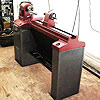Hey folks,
So I have to ask a bit of a basic question. I am learning to make cabriolet legs for a highboy. Currently just practicing with glued up popular. Anyway I need to know which plane to get to smooth the sides from the bandsaw marks. Do I need a block plane or a small bench plane, high angle low angle?? The plan is to make the highboy out of curly maple. I got a Vertais spokeshave and cleans off the saw marks fast put i cannot get a flat surface from it. It might not be used for that purpose I dont know. Like I am say I am just learning hand tools.
Any help would be great. I have been an avid woodworker for a long time but never really used a tool unless it had a cord.
Thanks,
Scott




 Reply With Quote
Reply With Quote





